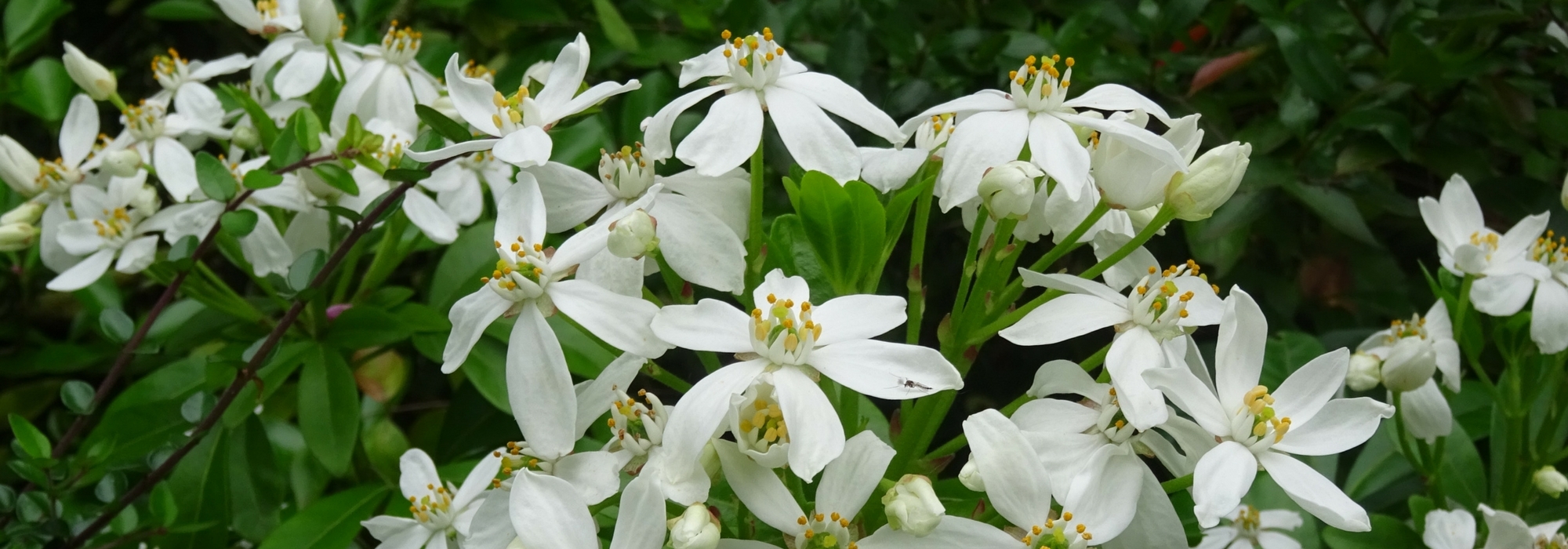
Mexican orange, Choisya: planting, pruning and care
Contents
Mexican Orange blossom in a nutshell
- Its evergreen and aromatic foliage smells divine
- The spring white flowering exudes an orange blossom fragrance
- Slow-growing, it is very hardy down to -15°C
- Easy to grow in any well-drained soil, it withstands drought and sea spray
- In hedges or pots, it is a true treasure for the garden or terrace
A word from our expert
Its compact shape, modest dimensions, its bright evergreen foliage and springtime white flowers with a delicate citrus fragrance make the Mexican Orange Blossom or Choisya a valuable scented bush in all gardens, even those of modest size.
From the Mexican Orange Blossom ‘Aztec Pearl’ to choisya ternata ‘Sundance’ or ‘Goldfinger’ with its magnificent golden yellow leaves, all create a bright focal point in the garden, whether in hedges, as standalone plants, or grown in pots on a terrace.
Its glossy graphic foliage, dark green to golden yellow, provides a touch of greenery all year round, punctuated by numerous clusters of white flowers at the end of spring, sometimes re-flowering in autumn.
Highly hardy (-10/-15°C), Choisya is tolerant in any well-drained soil where it grows slowly, sheltered from cold winds and stagnant moisture.
Little susceptible to diseases, it withstands drought well and is resistant to sea spray, making the Mexican Orange Blossom an asset in a contemporary garden, in a coastal garden, or in an exotic-inspired garden; its appearance and fragrance are particularly transporting.
It ranks among the most beautiful spring-flowering bushes. Discover our collection of Mexican Orange Blossom varieties at all prices and let yourself be charmed by this wonderfully fragrant and floriferous bush.
Botany
Botanical data
- Latin name Choisya ternata
- Family Rutaceae
- Common name Mexican Orange Blossom, Choisya
- Flowering April, May and a second bloom in September
- Height 1 to 3 m
- Exposure Sun, partial shade
- Soil type All, well-drained
- Hardiness -10°C/-15°C
L’Mexican Orange Blossom, Choisya ternata belongs to the botanical family of Rutaceae, like citrus trees. The genus Choisya includes 8 species of evergreen bushes native to the mountains of Mexico and the southern United States. It has acclimatised in our regions where it has become very hardy. The type species Choisya ternata is the most cultivated and the hardiest. It has given rise to several cultivars and hybrids highly valued for their superb bright and graphic foliage, such as ‘Sundance’, ‘Goldfinger’, or ‘Aztec Pearl’.
This bush exhibits vigorous growth. All Choisya form a dense and compact bush with a rounded habit as wide as it is tall, reaching up to 3 metres at maturity. Slow to establish, with slow growth, Choisya requires several years to sufficiently fill out and reach its full potential.
Its branches with smooth green bark bear graphic and aromatic foliage. Glossy, shiny green, more or less light, it is the main attraction of the bush. The evergreen, shiny leaves, opposite, ovate, and palmate are divided into 3 or 7 leaflets. Very narrow, they measure from 2 cm to 8 cm long and are grouped in threes (hence the name ternata, which means in threes) and connected to the stem by a long petiole. Dark green, bright yellow (Choisya ternata ‘Sundance’) or golden yellow (‘Goldfinger’) in spring, they turn green later. When crushed, they release a strong, fresh, and spicy scent of orange peel and green pepper.
The Mexican Orange Blossom offers a abundant spring flowering that also releases a delicate citrus fragrance. Clusters of small flowers, usually pure white, measuring 2 to 3 cm in diameter, are grouped in corymbs at the tips of the branches, blooming abundantly in May-June, and sometimes reblooming in autumn, in September-October (up to November-December in mild climates). They open into star-shaped corollas, consisting of 5 to 6 well-spaced white petals that conceal a bouquet of stamens with bright orange anthers at their heart. The Choisya ‘Apple Blossom’ stands out with its bicoloured pink-tinged flowers. Their orange blossom scent attracts pollinating insects, both bees and butterflies. They give way to fruits in the form of small capsules that release seeds at maturity.
Robust and drought-resistant, the Mexican Orange Blossom is easy to grow in sun or partial shade, in most regions. It thrives in any fresh, rich, and very well-drained soil, even slightly acidic. Hardy down to -12 °C to -15 °C, its hardiness can sometimes be challenged in the north of the Loire during prolonged frost. It prefers warm, sunny situations and protection from cold winds that may scorch its leaves.
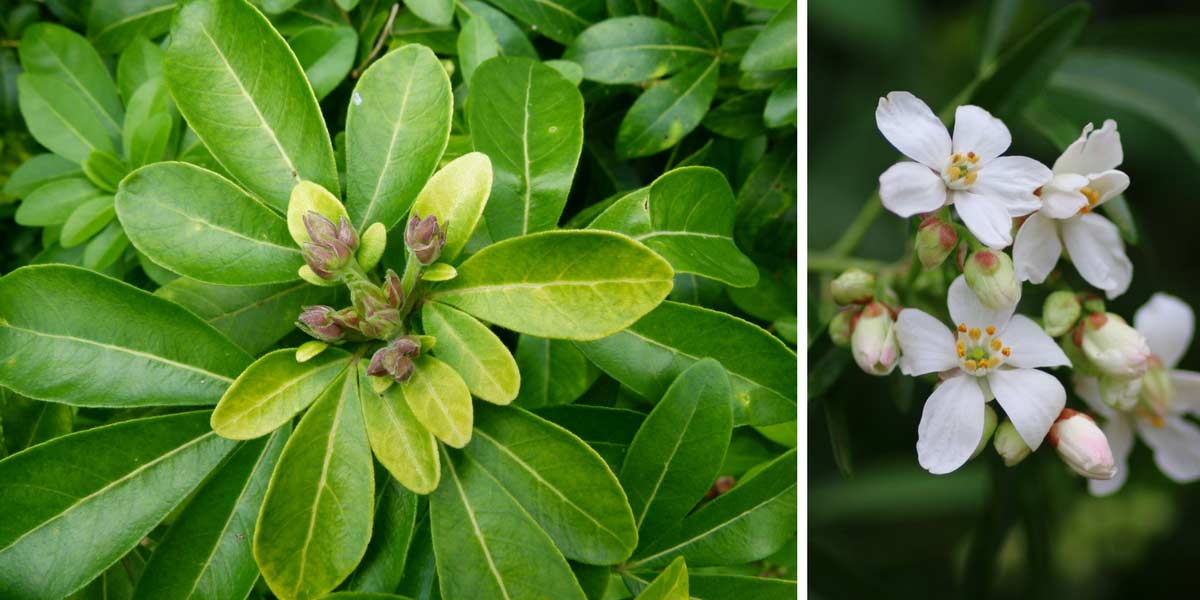
The evergreen foliage and fragrant flowering of the Mexican Orange Blossom are its main assets
With its evergreen foliage, attractive appearance, and exotic fragrance, it will be a lovely decorative feature all year round in all. Choisya lends itself to multiple uses; near an entrance to enjoy its delicate fragrance, in a large bed, in a large pot on the terrace or balcony, in a small free-form hedge, alongside Escallonia, old roses, Abélia, or dwarf buddleias.
Read also
Be attentive to evergreen bushesSpecies and main varieties
In addition to the common variety Choisya ternata, there are a small number of remarkable varieties and hybrids known for their beautiful bright foliage all year round, such as ‘Sundance’ with golden leaves, ‘Goldfinger’, and ‘Aztec Pearl’ with its finely cut, very graphic leaves.
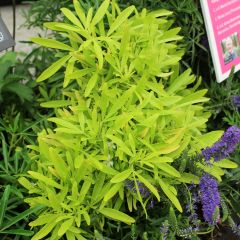
Choisya Goldfinger - Mexican Orange Blossom
- Flowering time June, July
- Height at maturity 2 m
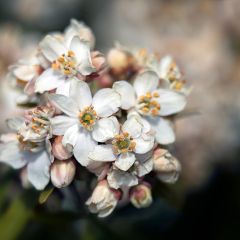
Choisya Aztec Pearl - Mexican Orange Blossom
- Flowering time June, July
- Height at maturity 2 m
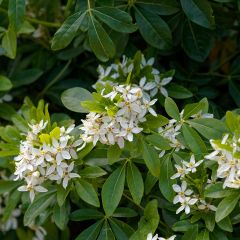
Choisya ternata - Mexican orange blossom
- Flowering time May to October
- Height at maturity 2 m
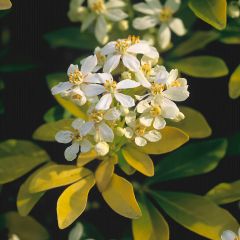
Choisya ternata Sundance - Mexican orange blossom
- Flowering time July to November
- Height at maturity 2 m
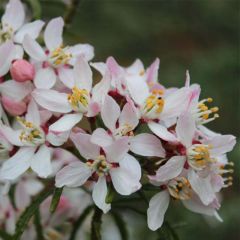
Choisya ternata Apple Blossom - Mexican Orange Blossom
- Flowering time May to October
- Height at maturity 1,20 m
Discover other Choisya - Mexican Orange Blossom
View all →Available in 0 sizes
Available in 0 sizes
Available in 4 sizes
Available in 2 sizes
Available in 4 sizes
Available in 3 sizes
Available in 2 sizes
Available in 1 sizes
Available in 1 sizes
Available in 2 sizes
Planting
Where to plant?
Choisya grows everywhere in France. While it tolerates shade in regions with hot summers, in cold climates, it requires sunlight and a sheltered position from cold, drying winds. In the southern regions of the Loire, its foliage tends to scorch in the sun and therefore needs some shade. However, avoid too dense shade, it needs light to bloom well.
Behind its exotic appearance lies a beautiful vigorous bush that, once well established, can withstand brief frosts of around -15°C, as well as summer drought. It is a good bush for seaside gardens, as it withstands sea spray.
It prefers rich, well-draining soils. This low-maintenance bush grows in any light, humus-bearing soil, even slightly acidic and slightly calcareous, as long as it is well-drained: it fears waterlogged soils in winter, especially when young.
Versatile, this evergreen bush lends itself to multiple uses and adapts to all gardens; whether isolated, in a small free-standing hedge with plenty of light, at the front of a shrub or mixed border, or in a large pot on the terrace or balcony to enjoy its delicate hesperidium fragrance. Choisya is a bush that retains its interest throughout winter, when other plants are dormant.
→ Read also: What is the best place to plant a Mexican orange blossom?
When to plant?
Depending on your region, you will not plant at the same time. In cold regions subject to frost, planting in spring from March to April after the most severe frosts will encourage recovery. In contrast, in Mediterranean and mild regions, you will plant in late summer, from September to November.
How to plant?
The soil should be light and airy. In a free-standing hedge, space the feet of Choisya 60 to 80 cm apart.
- Soak the root ball in a bucket of water before planting.
- Avoid areas where water stagnates: add pumice or a good layer of clay balls at the bottom of the hole to ensure good drainage (its roots do not like stagnant moisture, especially in winter).
- Dig a hole three times wider and deeper than the pot.
- Plant the bush and mix half potting soil with garden soil to fill the planting hole.
- Water generously.
- In summer, water and mulch to keep the soil cool with a generous organic mulch of pine bark or plant small perennials to protect the base and limit watering.

Choisya offers a beautiful diversity of foliage, as seen here in the variety ‘Aztec Pearl’
Growing a Mexican orange blossom in a pot
It tolerates pot cultivation very well in the southern regions of the Loire. Its small size makes this type of use perfect. It will thrive for many years in full sun or partial shade, in a large container filled with a fresh, very well-draining mix of potting soil, well-decomposed compost, river sand, and good garden soil. Choose a large container of about thirty litres (30 to 40 cm in diameter) and create a bed of gravel or clay balls at the bottom. In a pot, careful monitoring of watering is necessary. Spread a mulch or plant small perennials to maintain soil moisture during summer. Repot every 2 to 3 years. Each spring, add a little compost to the surface. In case of severe frosts (-20°C), protect it with a winter cover.
→ Read also our guide 7 Mexican orange blossoms to grow in pots.
Maintenance, pruning and care
A well-established Mexican Orange Blossom requires little care to maintain its good health. Water regularly during the first year after planting to encourage establishment and during prolonged heat. In the following years, it will cope very well with drought.
Pruning is unnecessary during the first few years. Only intervene after 3 or 4 years to remove any dead or damaged branches caused by winter’s harshness or to perform light pruning to maintain a compact habit and encourage a second flowering in autumn. In May-June, after flowering, cut back the shoots of the year by half.
In the northern regions of the Loire, protect the bush from severe frosts and snow that can scorch its leaves, using a winter cover. Be cautious with heavy or clay soils; lighten the soil with gravel if necessary, as waterlogged soils in winter can compromise the Choisya’s otherwise commendable hardiness.
Spread a good layer of organic mulch (bark or pine needles, leaf litter), renewed each year, to keep its roots cool during the summer heat.
Choisya ternata is a hungry plant; in spring, you can apply well-matured compost to the surface.
→ Learn more with our advice sheet on the pruning of the Mexican Orange Blossom and on the protection of the Mexican Orange Blossom in winter.
Diseases and potential pests
Very resilient, the Mexican Orange Blossom is not afraid of much. When grown in good conditions, it is relatively insensitive to diseases and pests. Snails in spring may occasionally feast on the young shoots.
It primarily fears cryptogamic diseases caused by fungi that develop in poorly drained soil or where moisture stagnates at the roots. Its main enemy: Phytophthora, a soil-borne fungus whose attack can kill it outright. The foliage yellows, the branches decline, and the plant then dies quickly. These issues are rare if the cultivation advice is followed: plant in healthy soil, avoid excess water, and improve drainage. In heavy or clayey soil, lighten the earth with gravel and compost, as waterlogged soils in winter further diminish the hardiness of this bush.
→ Read also: Diseases and pests of Choisya or Mexican Orange Blossom
Propagating
The Mexican Orange Blossom is easily propagated by cuttings.
By semi-ripe cuttings
- After flowering, between July and September, take new shoots from the year, semi-ripe (semi-woody) measuring 8 to 10 cm long.
- Remove all leaves from the lower part of the shoot, leaving only 2-3 leaves maximum.
- Incise the bark for 2 to 3 cm in length.
- Plant the cuttings in a light and draining substrate made up of 50% sand, 50% turf.
- Place them in a frame at 18 °C.
- Regularly mist the cuttings with a spray bottle.
- Plant them in buckets as soon as new leaves have grown.
- Pot on in the following spring and keep them in pots for 1 year before planting them in the ground.
→ Learn more about the propagation of the Mexican Orange Blossom in our advice sheet!
Associating
Very versatile, the Mexican Orange Blossom is inspiring for a contemporary garden with an exotic feel as well as for a seaside garden where it can be used to create a small free-standing hedge or to dress a wall with other bushes like Abelias, or in a bed with perennials such as Heucheras, Rodgersia, or Astances.
In a large bed, it will be magnificent alongside Escallonias, old roses, or dwarf buddleias. A C. ternata ‘Goldfinger’ will add a touch of exoticism to a bed alongside a non-running bamboo like Fargesia murielae ‘Bimbo’, a Japanese grass Hakonechloa Macra ‘All Gold’, and a Pyracantha ‘Golden Sun’.
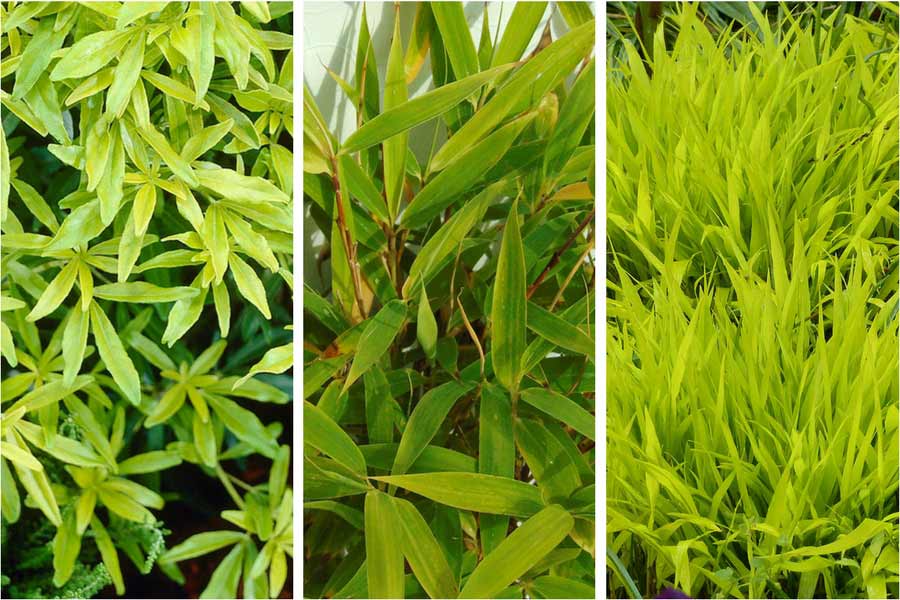
A very bright combination featuring Choisya ternata Goldfinger, Fargesia murielae Bimbo, and Hakonechloa macra All Gold
This fragrant bush provides an excellent evergreen backdrop for winter and spring flowers; it can be paired with more exuberant plants and lighter foliage such as that of ceanothus, grasses, or cistus. A spring-flowering climber like a Clematis will elegantly entwine itself in the foliage of a Choisya ternata.
The Choisya ternata ‘Sundance’ with its bright yellow-green foliage, close to pure gold in full sun, contrasts vividly with blue flowers such as those of creeping Bugle, Corydalis, irises, Brunneras, or hardy geraniums.
→ Discover also 7 ideas for pairing Choisya
Useful resources
-
- The most beautiful fragrant bushes are on our site, discover them!
- To grow a Mexican Orange Blossom in a pot
- Beautiful associations with Choisyas
- Protect a Mexican Orange Blossom in winter
- 7 ideas to associate the Mexican Orange Blossom
- Subscribe!
- Contents































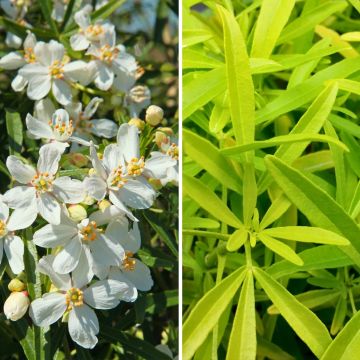
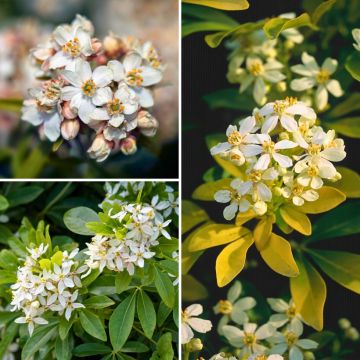




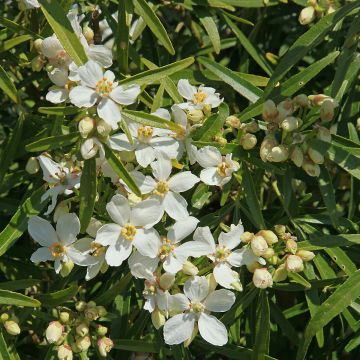
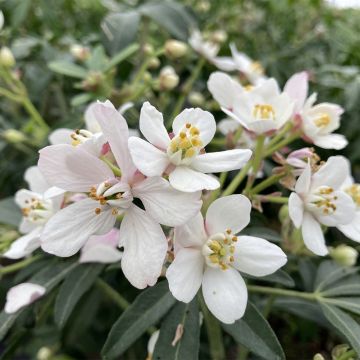
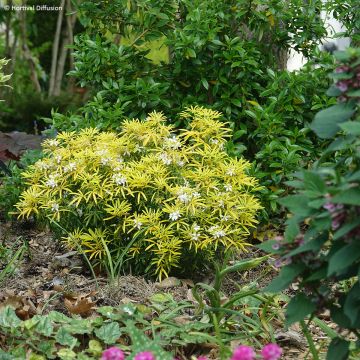
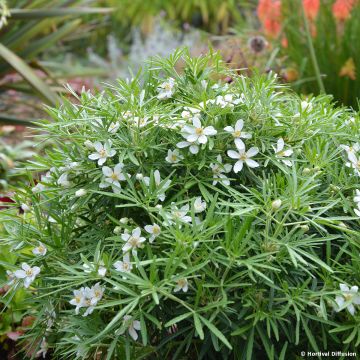
Comments